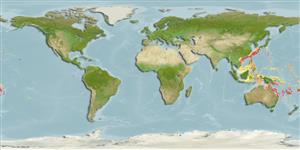Actinopterygii (ray-finned fishes) >
Perciformes (Perch-likes) >
Serranidae (Sea basses: groupers and fairy basslets) > Anthiinae
Etymology: Plectranthias: Greek, plektron = anyhting to strike with, spur + Greek, anthias = a fish, Sparus aurata (Ref. 45335).
Environment / Climate / Range
Ecology
Marine; reef-associated; depth range 80 - 300 m (Ref. 26833). Subtropical, preferred ?
Western Pacific.
Size / Weight / Age
Maturity: Lm ? range ? - ? cm
Max length : 11.1 cm SL male/unsexed; (Ref. 40960)
Dorsal
soft rays
(total): 17. Body moderately deep, depth 2.3 in SL. Head not completely scaled. Ventral margin of preopercle with no antrorse spine (Ref. 43101). Second soft dorsal not filamentous and third dorsal spine longest. Second branched caudal rays filamentous and a small red spot on the upper base of caudal fin. Body with 2 oblique red bands and a third narrow one from eye to thorax (Ref. 26833).
Life cycle and mating behavior
Maturity | Reproduction | Spawning | Eggs | Fecundity | Larvae
Chen, J.-P. and K.-T. Shao, 2002. Plectranthias sheni, a new species and P. kamii, a new record of anthiine fishes (Perciformes: Serranidae) from Taiwan. Zool. Stud. 41(1):63-68. (Ref. 43101)
IUCN Red List Status (Ref. 115185)
CITES (Ref. 94142)
Not Evaluated
Threat to humans
Harmless
Human uses
More information
Common namesSynonymsMetabolismPredatorsEcotoxicologyReproductionMaturitySpawningFecundityEggsEgg development
ReferencesAquacultureAquaculture profileStrainsGeneticsAllele frequenciesHeritabilityDiseasesProcessingMass conversion
Tools
Special reports
Download XML
Internet sources
Estimates of some properties based on models
Phylogenetic diversity index (Ref.
82805): PD
50 = 0.5000 [Uniqueness, from 0.5 = low to 2.0 = high].
Bayesian length-weight: a=0.02455 (0.00951 - 0.06333), b=2.98 (2.75 - 3.21), in cm Total Length, based on LWR estimates for this (Sub)family-body shape (Ref.
93245).
Trophic Level (Ref.
69278): 4.0 ±0.6 se; Based on size and trophs of closest relatives
Resilience (Ref.
69278): High, minimum population doubling time less than 15 months (Preliminary K or Fecundity.).
Vulnerability (Ref.
59153): Low vulnerability (20 of 100) .
